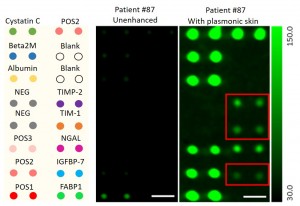
Researchers from multiple disciplines at Washington University St Louis (WUSTL) and the Air Force Research Laboratory (AFRL) at Wright-Patterson Air Force Base, both in the US, have developed an add-on plasmonic patch with metal nanostructures to enhance the fluorescence intensity in fluorescence-based biosensing and bioimaging by 100 times. While fluorescence-based detection and imaging techniques are convenient, they characteristically suffer from poor sensitivity. This patch could now provide an inexpensive, easy solution researchers can rely on.
The simple and universal method is based on what the team calls a “plasmonic patch” — a thin, flexible film with adsorbed metal nanostructures on its surface. “These plasmonic nanostructures act as antennae: They concentrate light into a tiny volume around the molecules emitting fluorescence,” explains Jingyi Luan, a graduate student in the Soft Nanomaterials Laboratory at WUSTL and primary author of the paper “Add-on plasmonic patch as a universal fluorescence enhancer,” published in the journal Light: Science and Applications. Once applied on a surface with fluorescent molecules, the plasmonic patch enhances the emission — or the brightness — of the fluorescent species by up to 100 times, significantly improving the sensitivity of these diagnostic tests by two to three orders of magnitude.
New universal approach, simple fix
“The most unique aspect of this approach is that it does not require any changes to the existing assay or imaging procedures or materials,” Luan points out, elaborating that the plasmonic patch is a universal approach that can be added onto a broad range of fluorescence-based biodetection tests as the last (and new) step, without changing the original workflow of these tests.
Applications and impact on biomedical research
The plasmonic patch is particularly useful for high-throughput and multiplexed microarray, where multiple biomarkers can be examined at the same time. Luan notes that with this plasmonic patch, the limit-of-detection and dynamic range of these assays are significantly improved.
“The first and most immediate impact will be in biomedical research,” she says about her team’s innovation. “Biomedical and clinical researchers are always interested in assays and imaging techniques that are simpler and more sensitive. The plasmonic patch precisely caters to that need.”
A primary advantage of the plasmonic patch is that it enables the detection and visualization of target biological species at significantly lower concentrations without significantly changing the established procedures. Now potentially significantly improving signal intensity and assay sensitivity, the plasmonic patch might also lead to the development of portable and less expensive medical readout devices useful for point-of-care testing in resource-limited areas.
The crux: Tuning the spacer layer
“The most surprising thing is the effect of the spacer layer on the final fluorescence enhancement efficiency,” Luan says. The team tuned the distance — the “spacer layer” — between the plasmonic patch and the fluorophores underneath and noticed significant change in the fluorescence enhancement efficiency. “Even 1 nm can make a significant difference, suggesting the importance of the fine control of the ‘spacer layer,’ “ she says.
Next step
Continuing with this research work, the team plans to further improve the enhancement efficiency and apply the plasmonic patch to DNA/RNA microarrays and fluorescence-based imaging techniques.
Written by Sandra Henderson, Research Editor, Novus Light Technologies Today























 Back to Features
Back to Features

























